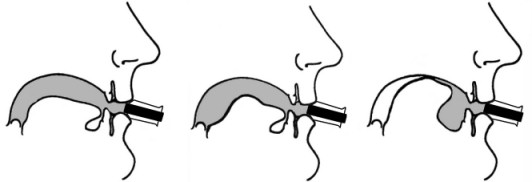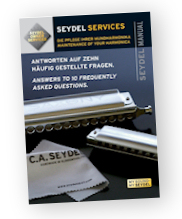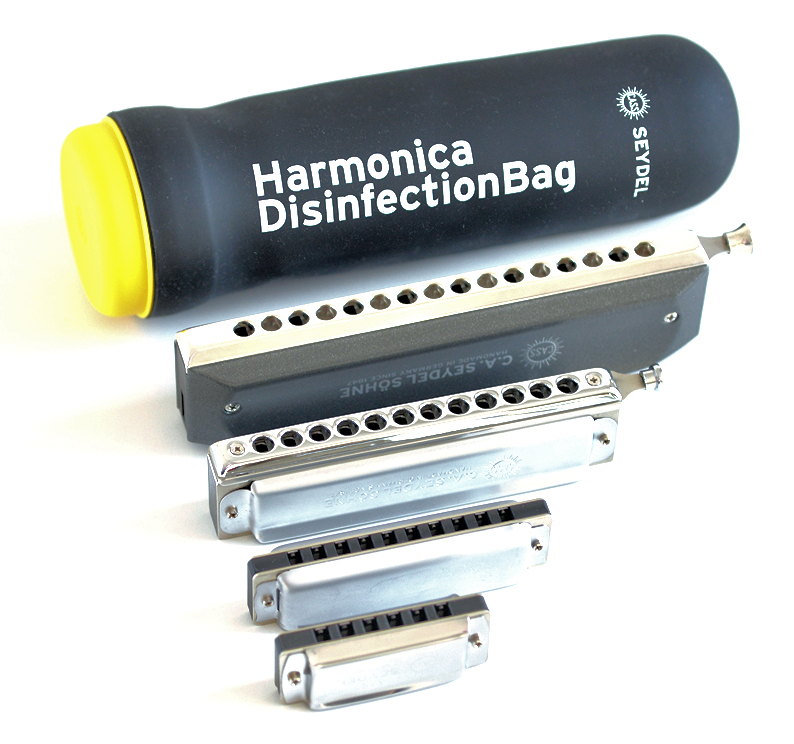Tips for maintenance
The following tips will help you to get the best out of your harmonicas for a long time.
Maintenance tips for the Triola can be found at the end of this document.
Operating Temperature
Please ensure that the harmonica is at room temperature when you start to play it. You can warm the instrument by blowing gently into it to warm the reeds.
If the temperature of the reeds is below 50°F (10°C) they may respond as if they are sticking.
Play your new harmonicas gently and with minimal force. Acquaint yourself with the feeling of the reed response to your breath. Our instruments are extremely airtight and may require less air than other harmonicas you are used to playing.
Why reeds can break?
In principle, a reed is a spring-mass system; each spring has an upper load limit. The upper load limit is higher for stainless steel reeds than it is for brass reeds, but all reeds can reach that limit and break.
The reason for early reed failure or detuning is a too high playing pressure often combined with the wrong playing technique. Furthermore reeds generally are wearing out while acting, this cannot be prevented.
While it is true that reeds wear whenever they are actuated, oftentimes, early reed failure or detuning is the result of high air pressure when playing, combined with a poor playing technique.
If you have an instrument with a broken reed, please send it to one of our service partners or directly to our factory in Klingenthal, Germany. You may choose to repair the instrument yourself by purchasing spare reedplates or individual reeds as well as instructional material from Seydel for a do-it-yourself repair.
Blowing in the right way
Avoid playing with high air pressure. The proper way to play is to think about playing like breathing. Learn to feel the reed being actuated by your breath. Play deeply from your diaphragm. You will improve your tone, will be able to play longer, and will extend the life of the reeds by playing gently but with deeper breaths.
Proper Embouchure
Producing high volumes and good sounding notes is not a matter of high playing pressures but a result of playing with the right embouchure.
Good tone and clear, clean notes do not come by playing forcefully, but by playing with proper embouchure.
Try different mouth-cavity shapes if you want to play notes in different pitches - low notes require a longer air-column than higher notes - so if you find the right "room" for a particular note you will find out that you can make it "sing" without raising the playing pressure too much.
Low notes require a longer air column that higher notes. If you play with proper embouchure and understand that your mouth cavity is a part of the instrument, you will discover how to make the harmonica sing without excessive air pressure.

Left: Mouth cavity for playing low notes (like the vowal "U"), middle: mouth cavity for medium pitched notes (like the vowel "AE"), right: mouth cavity shape for playing high notes (like the vowel "E")
Your embouchure, the shape of the mouth cavity in combination with the position of the lips, tongue, and teeth, affects the tone of the instrument. You and your harmonica form a “functional unity.”
Bending and Overblowing
You can produce the missing notes on a diatonic harmonica by learning the playing techniques of bending and overblowing. Both of these techniques are not dependent on high air pressure, which may fatigue the reeds, but rather on proper embouchure, good reed adjustment, and practice.
It makes no sense to force the notes out with too high playing pressure, because the reeds would suffer a lot and get out of tune very fast.
Valve Maintenance
When you play a valved instrument, be aware that excessive saliva can glue the valves together and prevent them from functioning properly. Each valve consists of two foils, one covering the reedslot on the reedplate and the other, a stabilizing top sheet. When saliva in the harmonica dries, the residue that is left may glue the two foils of the valve together.
To remedy a stuck valve, carefully separate the foils using a needle, then insert a moistened piece of paper in between the foil. A clean, unused coffee filter provides good paper for this purpose. Fit the paper between the foils while holding the valve lightly with your finger. You will clean out the dried residue. Do the same thing between the reedplate and the valve.
Valves are wear items and are not covered by warranty. If you need new valves for your instrument, please contact Seydel Service Department. You can also order spare valves in our eShop.
Slider Maintenance
Sliders on harmonicas may become sluggish due to saliva and dust. You can clean the slider by dipping the instrument into a flat basin with water. Hold the instrument so the mouthpiece is facing down and only dip it so the slider is submerged, but no further. While the slider is submerged, move the slider back and forth until it moves freely. Pay attention so that water does not enter the instrument where it may damage the valves!
Dry the slider the tapping the instrument, mouthpiece first, on your hand. You can do this every time you are finished playing to keep the slider in top working condition.
If the slider sticks because it is bent, contact Seydel Service or purchase a new slider in the eShop.
Cleaning Reedplates and Combs
Reedplates and combs are subject to buildup of dust and saliva and need to be cleaned periodically. In addition to keeping the instrument playing properly, you also benefit by having a clean, more hygienic instrument.
You can disassemble all Seydel Blues model harmonicas by using a Pozidriv® PZ0 or Philips screwdriver. Remove the screws that hold the cover into place and put them in a container so you will not loose them. Wipe the coverplates with a damp cloth. You can use a soft toothbrush to clean debris from the covers while running them under warm water. You can rinse the comb, with the reedplates still attached, under warm water to dissolve any dried saliva and to remove dust and debris. Do not scrub the reeds with the toothbrush. DO NOT perform this cleaning if your instrument is valved as the water will damage the valves. Because Seydel seals the wooden combs of the Blues model harmonicas, there is no need for concern about wood swelling after being in contact with the water.
Reedplates are very delicate and you can upset the offset of the reed very easily if you are not careful when cleaning the instrument. You can separate the reedplates from the comb by using the same screwdriver that you used to remove the coverplates. Be careful to place the screws in a safe place. They are small and can be easily lost. You can remove debris from the reedplates with very gentle and careful use of the toothbrush or even a wooden toothpick. Be careful not to flex the reeds. You can very easily damage the reeds or change the offset.
After you have cleaned the components, dry them, first by gentle tapping on your hand, then by a soft cloth. DO NOT dry the reedplates with a cloth because you can easily snag a reed and damage it or change its position.
When you reassemble the instrument, be care not to over-tighten the screws. Also, keep in mind that the instrument may need slight alignment and adjustment. Do not tighten the screws fully until you verify that it is assembled properly and the alignment of the comb, reedplates, and covers, is such that the instrument is still airtight. On instruments with a channel in the reedplate, make sure that the coverplates click into the channel while you tighten the coverplate screws to ensure that the covers fit properly and offer an airtight seal. Do not over-tighten screws as you can damage the screws and the instrument.
Alternately, metal parts of all blues models (without valves) can be submerged in an ultrasonic cleaner filled with water. Do not use any cleaning agents, only water!
Disinfection of Harmonicas (optional)
Disinfection is always the last step of a complete cleaning procedure. The >Harmonica Disinfection Bag disinfection is based on gaseous Ozone and works effectively without an fluids and residues - as well for Chromatic harmonicas or other valved models.
Seydel Repair Service
We offer professional repair services at competitive prices. We perform general maintenance, reed replacement, reedplate replacement, tuning, valve renewal, slider repair and replacement, and many other procedures to keep your instrument in top playing condition.
Please send the cleaned instrument with a short description of the problem. Include your full address, telephone number, and e-mail address. While in some cases, repair may take a longer time, typically, repairs are completed within a few working days of receiving the instrument.
IMPORTANT! Improper adjustment and repair work will void the manufacturer’s warranty.
Maintenance Tips for the Triola
- Food and drink, especially sugared drinks, can damage the Triola. Encourage your child to play with a clean mouth. Proper oral hygiene will help ensure that the instrument plays well and lasts longer.
- Allow the instrument to dry out completely before placing it back into its case.
- Teach your child to use his or her lips to hold the mouthpiece in place, not teeth. Biting the mouthpiece will damage it and does not allow the player to produce a full and proper tone.
- Do not disassemble the instrument. The air-tightness of the instrument will be compromised. Instead, please send us defective instruments for repair.









